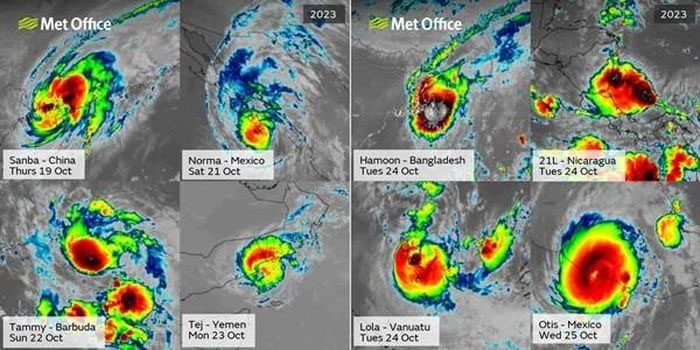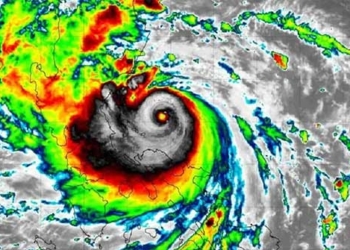October 2023 is considered an unusually stormy month worldwide, particularly over the oceans, where storms have formed continuously. Not only that, but there have been 8 storms making landfall within just one week, leaving meteorological experts puzzled, with some events being completely unforecastable.
The world is experiencing a very strange October weather-wise, especially regarding storms, from the Pacific Ocean to the Atlantic Ocean and even in the Arabian Sea.
According to the UK Met Office, the most unusual aspect is that within just one week, there were 8 storms – not only storms forming over the sea but also storms making landfall across the globe. These include: Typhoon Sanba (known as Storm No. 5 in Vietnam) making landfall in China on October 19; Storm Norma making landfall in Mexico on October 21; Storm Tammy making landfall in Barbuda on October 22; Storm Tej making landfall in Yemen on October 23; Storm Hamoon making landfall in Bangladesh on October 24; Tropical Depression 21L making landfall in Nicaragua on October 24; Super Typhoon Lola making landfall in Vanuatu on October 24; Super Typhoon Otis making landfall in Mexico on October 25.

8 storms making landfall worldwide in just one week. (Photo: Met Office).
The storms forming far to the east in the Atlantic Ocean are also quite unusual for October, such as Storm Sean near Africa. This phenomenon is typical in August and September, but not in October. According to scientist Phil Klotzbach from Colorado State University, Storm Sean is the farthest east October storm ever recorded in the Atlantic. The following week, Storm Tammy also set a similar record.
In the Eastern Pacific, four storms made landfall within two weeks. Among them, Super Typhoon Otis was the most terrifying, as it intensified from a regular tropical storm to a super typhoon (Category 5) in less than 24 hours, catching even meteorological stations off guard, let alone the local population.

Residents observing the damage caused by Super Typhoon Otis in Acapulco, Mexico. (Photo: Henry Romero/Reuters).
In the Southwest Pacific, there is also an unusually strong and early storm, Super Typhoon Lola. Lola is the strongest October storm recorded, based on wind speed, in this region. Another oddity is that the storm season in the Southwest Pacific has just begun. Since the 1970s, there have only been 10 instances of storms in this area during October.
Additionally, one storm set a record by dropping the equivalent of 8 years’ worth of rain! Storm Tej has become one of the 10 strongest storms ever recorded in the Arabian Sea, according to Yale Climate Connections. When it made landfall in Yemen, this storm produced rainfall that no meteorological station could predict. According to the Yemen Meteorological Service, the city of Al Ghaydah received 431.8 mm of rain from Storm Tej, which is equivalent to the total average rainfall over more than 8 years in that area. Consequently, eastern Yemen has experienced severe flooding.

Extensive flooding in Yemen caused by Storm Tej. (Photo: The Weather Channel).
Meteorologists are currently considering one possible cause for the unusual storms, which is the warming of ocean surface temperatures, but this is not the only reason. Continuous monitoring will be necessary to understand why so many strong storms, off-season storms, and continuous landfall events occurred in October this year.




















































